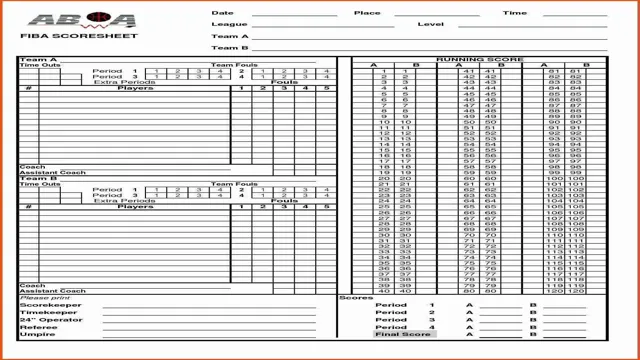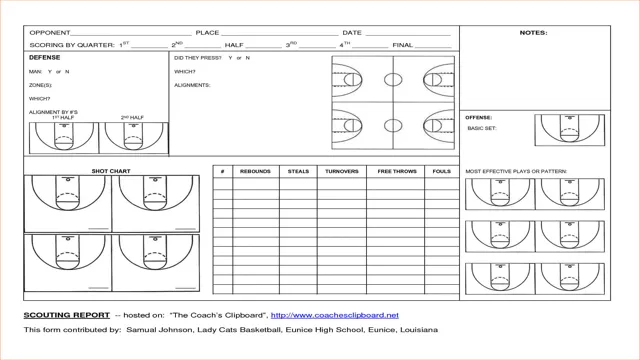If you’re a basketball coach, you know that scouting your opponents is essential to winning games. But how do you effectively keep track of all the information you gather about each player and team? That’s where basketball scouting sheets come in. These sheets are like a roadmap to victory, allowing you to track everything from shooting percentages to defensive tendencies.
With a bit of time and effort, creating effective scouting sheets can help take your team to the next level. In this blog post, we will delve into the ins and outs of basketball scouting sheets, discussing what they are, why they matter, and how to create them. So read on and prepare to take your basketball coaching game to new heights!
What are Basketball Scouting Sheets?
Basketball scouting sheets are an essential tool that coaches and scouts use to evaluate players’ skills and abilities. These sheets include various categories such as shooting, passing, ball-handling, defense, and rebounding for every player in a particular game. Coaches use these sheets to identify a player’s strengths and weaknesses, which they can then use to develop the player’s skills.
Additionally, teams can use these sheets to gain a competitive edge over opponents by scouting their strategies and determining which players to focus on. With the help of basketball scouting sheets, coaches and scouts can make better-informed decisions during games and ultimately improve their chances of winning.
Different Types of Scouting Sheets
Basketball scouting sheets are tools used by coaches and teams to assess their opponents and develop game strategies. These sheets are essential in capturing a team’s strengths and weaknesses, enabling coaches to develop effective plans that exploit their opponents’ faults while capitalizing on their strengths. They come in different types, such as player evaluation sheet, team stats sheet, and shot chart sheet.
Player evaluation sheets contain a comprehensive analysis of each player, such as their playing style, skills, performance, and overall impact on the game. Team stats sheets provide a team’s performance data, such as point and rebound statistics. Finally, shot chart sheets provide an analysis of a team or player’s shooting performance from different locations on the court.
Overall, basketball scouting sheets offer a systematic approach to analyzing and understanding opponents, providing necessary information that helps teams win games.

Benefits of Scouting Sheets for Basketball Players
Basketball Scouting Sheets Basketball scouting sheets are an essential component for developing a winning basketball team. They include a set of statistics that provide coaches with valuable information about their team’s performance. The sheets help coaches to identify the strengths and weaknesses of their players, and make strategic decisions that can help the team advance.
The benefits of using scouting sheets are many, including improved player development, better time management, and a higher level of team cohesion. By analyzing the data in their scouting sheets, coaches can identify patterns in their team’s performance and create new strategies to capitalize on strengths and address weaknesses. Overall, using basketball scouting sheets is an excellent way to help your team be successful on the court, and an organized and efficient way to monitor progress.
How to Use Basketball Scouting Sheets?
If you’re a basketball coach or scout, then you’re no stranger to the term “basketball scouting sheets”. These sheets are an essential tool used to evaluate players and teams. Their main purpose is to record and analyze data during games or practices, providing insight into areas of strength and weakness for players and teams alike.
With basketball scouting sheets, coaches and scouts can quickly and easily identify player tendencies, track their progress, and make informed decisions about game strategies. Additionally, scouting sheets can be shared with team members to help them understand where they need to improve and what skills they need to work on. All in all, basketball scouting sheets are a must-have for any serious coach or scout looking to improve their team’s performance and ultimately win more games.
Creating a Scouting Report
When it comes to creating a scouting report for basketball players, utilizing a basketball scouting sheet can be extremely helpful. These sheets, also known as player evaluation forms, allow scouts to objectively evaluate an athlete’s performance based on specific categories such as shooting, ball-handling, defense, and overall athleticism. By using a scouting sheet, scouts can track and compare players’ skills and progress over time.
It’s essential to use consistent terminology and scoring systems when filling out scouting sheets to ensure accuracy and make comparisons between players easier. By regularly using basketball scouting sheets, scouts can create comprehensive reports that identify a player’s strengths and areas for improvement, providing valuable insight for coaches and teams. Overall, utilizing a basketball scouting sheet is a critical tool for creating an accurate and detailed scouting report.
Analyzing Data on Scouting Sheets
Basketball Scouting Sheets Basketball scouting sheets are an essential tool for coaches and scouts tasked with evaluating players’ performances. These sheets contain critical information on players’ strengths, weaknesses, and performance metrics that enable coaches to analyze and strategize different aspects of the game. However, using scouting sheets can be a daunting task, especially for new coaches.
The first step in using a scouting sheet is to identify the essential information that needs to be noted down. This may include the player’s name, position, height, weight, and primary skills, such as shooting, rebounding, and defense. Once this information has been collected, coaches can then use it to analyze the player’s performance over time and compare it with other players.
With this information, coaches can develop training strategies that focus on improving players’ weaknesses and reinforcing their strengths. Overall, basketball scouting sheets are a valuable tool that helps coaches gain insight into player performance and develop effective strategies for improving their team’s performance on the court.
Using Scouting Sheets in Game Strategy
Basketball Scouting Sheets Basketball scouting sheets are an essential tool for teams and coaches to prepare for upcoming games. These sheets provide a detailed analysis of opponents’ strengths and weaknesses, scouting reports, set plays, and strategies that can be used to help the team gain an edge on game day. The most effective scouting sheets are those that focus on the specific strengths and weaknesses of individual players and incorporate that into the overall game plan.
To determine these, the coaching staff often spends hours reviewing footage and statistics to create the most effective scouting sheets possible. Once these are developed, it is essential to ensure that all players are familiar with the game plans outlined in the scouting sheets and understand which strategies to employ in specific situations. By studying scouting sheets ahead of time and putting them into practice in game-play, it can allow teams to compete at the highest level and give them the best chance of success on the court.
Examples of Basketball Scouting Sheets
Basketball scouting sheets are a vital tool in the arsenal of every basketball coach. These sheets serve as a detailed record of each player’s strengths, weaknesses, tendencies, and overall performance. A scouting sheet usually contains information about the player’s height, weight, shooting range, ball-handling abilities, defense, and footwork.
It also includes a section for individual notes and observations. Basketball scouting sheets help coaches and scouts track player development over time, identify areas that need improvement, and make informed decisions about player recruitment and game strategies. A well-designed scouting sheet can help coaches and scouts review and analyze data quickly and efficiently, providing invaluable insights into player performance and potential.
Some popular examples of basketball scouting sheets include the boxscore, play-by-play analysis, and shot chart. By using advanced metrics and data analysis tools, basketball scouts and coaches can gain a deeper understanding of the game and players, leading to better decision-making and more successful teams.
Sample Scouting Sheets for High School Players
When it comes to scouting high school basketball players, creating a scouting sheet is an essential tool for coaches and recruiters. These sheets provide a detailed overview of a player’s strengths, weaknesses, and overall potential. When creating a scouting sheet, it’s important to include basic information such as the player’s name, position, and jersey number.
Additionally, coaches should pay close attention to a player’s offensive and defensive skills, including shooting ability, ball handling, and footwork. Other factors to consider include a player’s athleticism, leadership qualities, and ability to handle pressure situations. By carefully analyzing a player’s abilities and potential, coaches and recruiters can make more informed decisions about which athletes to pursue.
Whether you’re a coach, recruiter, or simply a fan of the game, creating a scouting sheet is an excellent way to gain a deeper understanding of the skills and abilities of high school basketball players.
Scouting Sheets for NBA Teams
Basketball Scouting Sheets Basketball scouting sheets have become crucial for NBA teams as they help in identifying specific skills and traits of each player. These sheets consist of details like player strengths and weaknesses, shooting percentages, shot types, and overall effectiveness on both offense and defense. Coaches and analysts use these sheets to develop strategies and make informed decisions during games and player acquisitions.
Examples of basketball scouting sheets include the “draft index” and the “advanced statistical profile” which assist teams in evaluating prospective players based on numerous criteria. These sheets help teams to break down the game into specific actions and metrics and gather relevant data for decision making. Overall, scouting sheets are an essential tool that enables NBA teams to make data-driven decisions crucial for their success in today’s game.
Conclusion and Final Tips
After pouring through countless basketball scouting sheets, I’ve come to the conclusion that there’s nothing more exhilarating than analyzing the nuances of the game. From dissecting a player’s shooting mechanics, to scrutinizing their defensive footwork, every detail carries meaning and purpose. It’s like being a detective, piecing together a story with every bit of evidence collected.
So if you’re looking for a cerebral and exciting way to dive deeper into the world of basketball, grab a scouting sheet and join the investigation. Who knows, you might just uncover the next Michael Jordan.”
FAQs
What information should be included in a basketball scouting sheet?
A basketball scouting sheet should include the player’s name, position, height, weight, strengths and weaknesses, offensive and defensive skills, shooting ability, rebounding skills, and athleticism.
How can basketball coaches use scouting sheets to improve their team’s performance?
Basketball coaches can use scouting sheets to identify their team’s weaknesses and strengths, create game strategies, and select the best players to match with the opponent.
What are some common mistakes to avoid in creating basketball scouting sheets?
Some common mistakes to avoid in creating basketball scouting sheets are not including key information, overloading with too much information, and relying solely on subjective opinions.
How can technology improve basketball scouting sheets?
Technology can improve basketball scouting sheets by allowing coaches to input and analyze large amounts of data, create customized reports, and compare players’ statistics and abilities.


